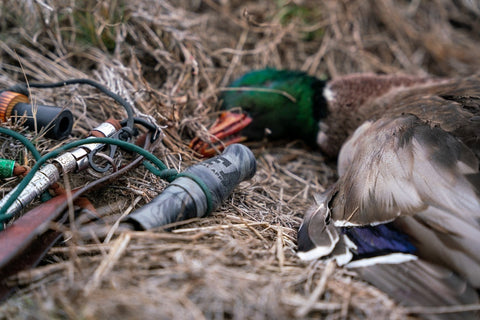
HOW TO BE A WATERFOWL SCOUT MASTER
HOW TO BE A WATERFOWL SCOUT MASTER by Brad Fenson
The perfect decoy spread, The invisible blind, The killer call. Duck hunters have been seeking the magic pill for at least the last 150 years. And I think I may have found it. Or maybe two. Or three …
Of course, it’s not a magic pill at all. It’s a magic place. To find it we must also learn to scan for perfect weather and the perfect date.
The Perfect Place
I know. This is the hardest part, but the most productive if you can pull it off.
We’ve all seen that private pond along the highway where all the mallards pile up during the season because no one gets to hunt it. We’ve heard of those hot springs that stay open all winter, ducks smothering the water like lily pads. And who doesn’t want to discover that pothole seething with ducks out in Guess where County so isolated that not even Google search can find it?
We all know about those perfect places where waterfowl whiffle in like autumn leaves. But few of us have permission to hunt them. So, we buy more decoys, blow more calls and re-patch the camouflage on the old blind. Hope springs eternal, but uncovering the perfect spot gets more birds.
“What’s over there?” I asked Ben Cole last September. He, Brad Fenson and I were crouched beside a brush-lined pond in the Saskatchewan parklands where the locals had taken limits just two days earlier. Yet all this day’s limits were piling in a half-mile north.
“I don’t know,” Cole said, “but they’re pouring in there. Wait, here’s a bunch heading right toward us. I’ll bet we can talk them in.” Whereupon he and Fenson unlimbered their calls and laid down enough hen talk to almost convince me to jump into our decoys. But the ducks didn’t circle—didn’t so much as bend a primary feather in our direction as they bored toward that haven to the north.

“What?” Fenson asked rhetorically. “Are they serving corn-off-the-cob up there?”
Probably not. Just uninterrupted solace. And once a few flocks start advertising their newfound paradise, word gets out. The best caller in the world can’t talk down a flock with somewhere better to go. Frustration station. We work our butts off making everything perfect, only to watch duck after duck plane into that hole 400 yards behind us.
Situations like this are the bane of waterfowl hunting. Here in the opening decades of the 21st century, we must spend as much time hunting for a place to hunt as hunting the place we find. But it’s mandatory. So …
Don’t settle for your same old spot. Look. Listen. Map. Fly. If birds consistently land just beyond those trees, try to determine why. Fly it with a camera drone if you must (and if it’s legal). Flooded grain field? Beaver pond surrounded by mast trees? Can you find a way to hunt that spot? Given today’s stiff competition for hunting rights, most of us assume every place is leased or owned by someone who does not allow hunting. That’s not always the case.
Don’t Overcall, But …
Most of us like to blow a call because, well, it’s something we can do. And it fulfills our on-stage rock star fantasies to some degree. But trust me, the ducks and geese might not share our enthusiasm.
“If the birds are approaching, just sit still,” “At most, give them a feeding chuckle or two. If they appear to be going away, try a comeback call or lonesome hen. If flocks are passing high, try the hail call, but if flock after flock ignores it, you’re probably just in the wrong spot.”
Despite that sage advice, don’t be afraid to call, either. Sometimes birds really do need a good talking to before they pay attention to you. Try calling aggressively at a few flocks to gauge how they respond. During one North Dakota hunt my hosts insisted calling didn’t work in that area. “No one calls much.” That suggested the flocks buzzing around us were probably open to something different. I called and we immediately worked birds right into our set. Sometimes all you have to do is what everyone else doesn’t do.
I once spotted ducks on a small pond along a county road. Local hunters insisted the landowner was a hard case who wouldn’t let anyone hunt. But I hadn’t grown up there, so as a complete stranger, I introduced myself to this hard-case farmer and asked if I could hunt. “Sure,” he said. “But only weekday mornings.” The birds were so accommodating that I took limits while using just six decoys and a 20-gauge.
If you can’t find the landowner nearby, check at the county government offices. They should have public records on who owns the ground. Next comes the hard part: screwing up your courage to ask. Just do it. Be polite, down-home friendly, personable, but honest. Offer to share, trade, or take the landowner or his kids hunting. This is about salesmanship. You’re selling yourself.
Sometimes gaining access to a hotspot is as simple as breaking inertia and moving.

“That’s the third flock that’s ignored our decoys and landed back in those reeds,” my buddy Brad said one November on a public hunting wetland. “Maybe we should move.”
“Pick up all these decoys?” I asked. “Naw, we can pull a few flocks in.”
Except we couldn’t. After two more flocks gave us the cold shoulder, we moved, discovered a “secret” hole deep in an expanse of impenetrable reeds, and flushed several hundred mallards, gadwalls and wigeon from it. But our move was a bit too late. We decoyed two small flocks before the morning flight was over, but we’d learned our lesson: Set up where the birds want to go—and do it early!